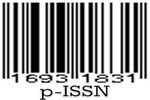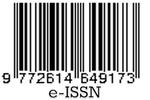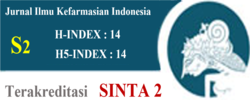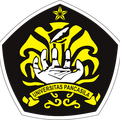Increased Cytotoxic Effect of Doxorubicin by Naringenin on T47D Cancer Cells through Apoptosis Induction
Abstract
Doxorubicin is one of the standard regiment for breast cancer chemotherapy, but resistance to this agent is often occured and long period usage will induce cardiotoxicity, Therefore, combination therapy (co-chemotherapy) is needed to improve the efficacy of doxorubicin and to reduce its systemic toxicity. Naringenin is one of the most abundant ilavonoids in citrus fruits which showed cytotoxicity in various human cancer cell lines and has mechanisms through pathways except p53. This research is aimed to examine the effect of naringenin in combination with doxorubicin against T47D breast cancer cell which is resistant to doxorubicin due to p53 mutation. The IC50 dan CI (combination index) values were detennined by the MTT assay, The apoptotic stimulation effect of narigenin and doxorubicin was performed by DNA staining using cthidum bromide-acridine orange. Naringenin and doxorubicin exhibited cytotoxic effect with IC50 of 509 µM and 15 nM, respectively. The CI value in all ratios of naringenin-doxorubicin showed synergistic effect (CI 0.20-0.89). Combination ofnaringenin-doxorubicin with concentration smaller than 12,5 µM-0.6 nM in 1:1 ratio exhibited an additive combination effect, The combined treatment increased the apoptotic effect of doxorubicin.These results show that naringenin is potential to be developed as co-chemotherapeutic agent with doxonibicin, although the molecular mechanism is still needed to be explored.
References
2. Zhang FY, Du GJ, Zhang L, Zhang CL, Lu WL, and Liang W. Naringenin Enhances the Anti-Tumor Effect of Doxorubicin Through Selectively Inhibiting the Activity of Multidrug Resistance-Associated Proteins but not P-glycoprotein, Pharmaceutical Research. 2009. 26(4):914-24.
3. Kanno S, Tomizawa A, Hiura T, Osanai Y, Shouji A, Ujibe M, Ohtake T, Kimura K, and Ishikawa M. Inhibitory Effects of Naringenin on Tumor Growth in Human Cancer Cell Lines and Sarcorna S-180- Implanted Mice, Biol Pharm Bull. 2005. 28(3): 527-30.
4. Jin CY, Park C, Lee JH, Chung KT, Kwon TK, Kim GY, Choi BT, and Choi YH. Naringenin-Induced Apoptosis is Attenuated by Bcl-2 but Restored by the Small Molecule Bcl-2 Inhibitor, HA 14-1, in Human Leukemia U397 Cells. Toxicology in Vitro. 2009. 23: 259-65.
5. Totta P, Acconcia F, Leone S, Cardillo I, and Marino M, Mechanisms of Naringenin-Induced Apoptotic Cascade in Cancer Cells: Involvement of Estrogen Receptor Alpha and Beta Signalling. IUBMB Life. 2004. 56 (8)1491-9.
6. Morikawa K, Nonaka M, Mochizuki H, Handa K, Hanada H, and Hirota K. Naringenin and Hesperetin induce Growth Arrest, Apoptosis, and Cytoplasmic Fat Deposit in Human Preadipocytes. J Agric Food Chem. 2008. 56: 11030-7.
7. Park JH, Jin CY, Lee BK, Kim GY, Choi YH, and Jeong YK. Naringenin Induces Apoptosis Through Downregulation of Akt and Caspase-3 Activation in Human Leukemia THP-1 Cells. Food and Chemical Toxicology. 2008. 46:3684-90.
8. Galluzzo P, Ascenzi P, Bulzomi P, and Marino M. The Nutritional Plavanone Naringenin Triggers Antiestrogenic Effects by Regulating Estrogen Receptor α-Palmitoylation. Endocrinology. 2008. 149(5): 2567-75.
9.Arafa HM, Abd-ellah MP, and Hafez HF. Abatement by Naringenin of Doxorubicin-Induced Cardiac Toxicity in Rats. Journal of the Egyptian Nat. Cancer Inst. 2005. 17(4): 291-300.
10. Reynolds and Maurer. Evaluating Response to Antineoplastic Drug Combinations in Tissue CultureModels in Methods in Molecular Medicine. Totowa, New Jersey: Humana Press Inc.;2005. 110: 173-83.
11. Vayssade M, Haddada H, Laurens LF, Tourpin S, Valen A, Benard J, and Ahomadegbe JC, p73 functionall replaces p53 in Adriamycin-treated, p53-deficient breas cancer cells, Int J Cancer. 2005, 116: 860-9.
12. Mizutani H, Oikawa ST, Hiraku Y, Kojima M, an Kawanishi S. Mechanism of Apoptosis Induced by Doxorubicin through The Generation, of Hydroge Peroxide. Life Sciences. 2005. 76 (13): 1439-53.
13. Tsang WP, Chau SPY Kong SK, Fung KP, and Kwo TT. Reactive Oxygen Species Mediate Doxorubici Induced p53-Independent Apoptosis. Life Sciences 2003. 73(16): 2047-58.
14. Drummond C. The Mechanism of Anti-tumour Activity , of the DNA Binding Agent SN 28049 [Thesis] University of Auckland, New Zealand; 2003. 17-19,
15. Han Z, Chatterjee D, He DM, Early J, Pantazis P Wyche JH, and Hendrickson EA. Evidence for a G2 Checkpoint in p5 3-Independent Apoptosis Induction b) X-Irradiation, Molecular and Cellular Biology. 1995. 15(11): 5849-57.
16. Ongkeko W, Ferguson DJP, Harris HAL, and Norbury C. Inactivation of Cdc2 Increases the Level of Apoptosi Induced by DNA Damage. Journal of Cell Science. 1995. 108:2897-904.
17. Tripoli E, Guardia ML, Giammanco S, Majo DD, an Giammanco M. Citrus flavonoids: Molecular structure, biological activity and nutritional properties: A review. Food Chemistry. 2007. 104: 466-79.
18. Adina AB, Handoko FF, Setyarini II, Septisetyan EP, Riyanto S, Meiyanto E. Ekstrak Etanolik Kuli Jeruk Nipis (Citrus aurantyolia (Cristm.) Swingle) Meningkatkan Sensitivitas Sel MCF-7 terhadap Doxorubicin. Proceding. Kongres Ilmiah ISFI ke-16.Yogyakarta: 2005. ISBN:978-979-95107-6-2.
Licencing
All articles in Jurnal Ilmu Kefarmasian Indonesia are an open-access article, distributed under the terms of the Creative Commons Attribution-NonCommercial-ShareAlike 4.0 International License which permits unrestricted non-commercial used, distribution and reproduction in any medium.
This licence applies to Author(s) and Public Reader means that the users mays :
- SHARE:
copy and redistribute the article in any medium or format - ADAPT:
remix, transform, and build upon the article (eg.: to produce a new research work and, possibly, a new publication) - ALIKE:
If you remix, transform, or build upon the article, you must distribute your contributions under the same license as the original. - NO ADDITIONAL RESTRICTIONS:
You may not apply legal terms or technological measures that legally restrict others from doing anything the license permits.
It does however mean that when you use it you must:
- ATTRIBUTION: You must give appropriate credit to both the Author(s) and the journal, provide a link to the license, and indicate if changes were made. You may do so in any reasonable manner, but not in any way that suggests the licensor endorses you or your use.
You may not:
- NONCOMMERCIAL: You may not use the article for commercial purposes.
This work is licensed under a Creative Commons Attribution-NonCommercial-ShareAlike 4.0 International License.

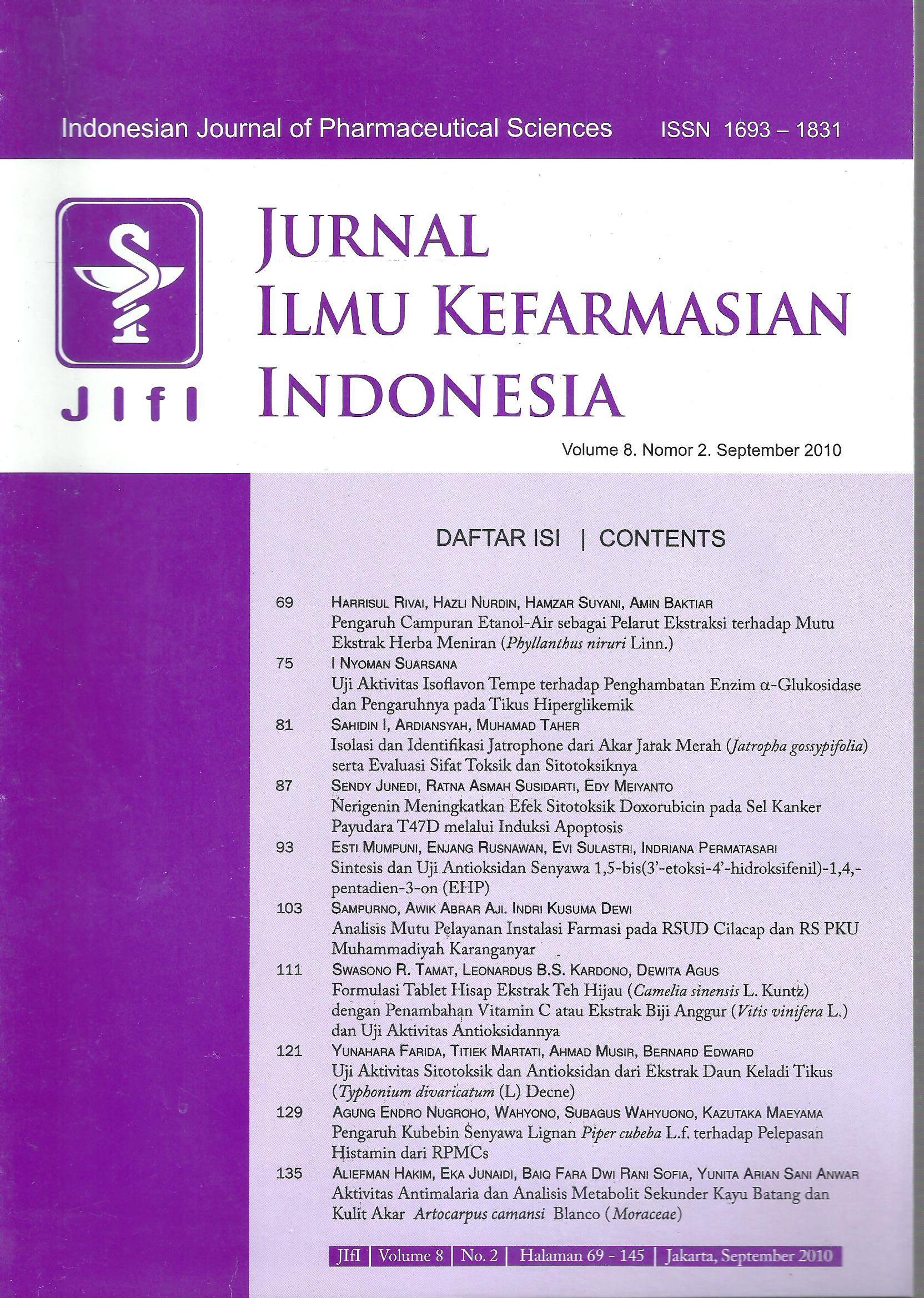



 Tools
Tools

